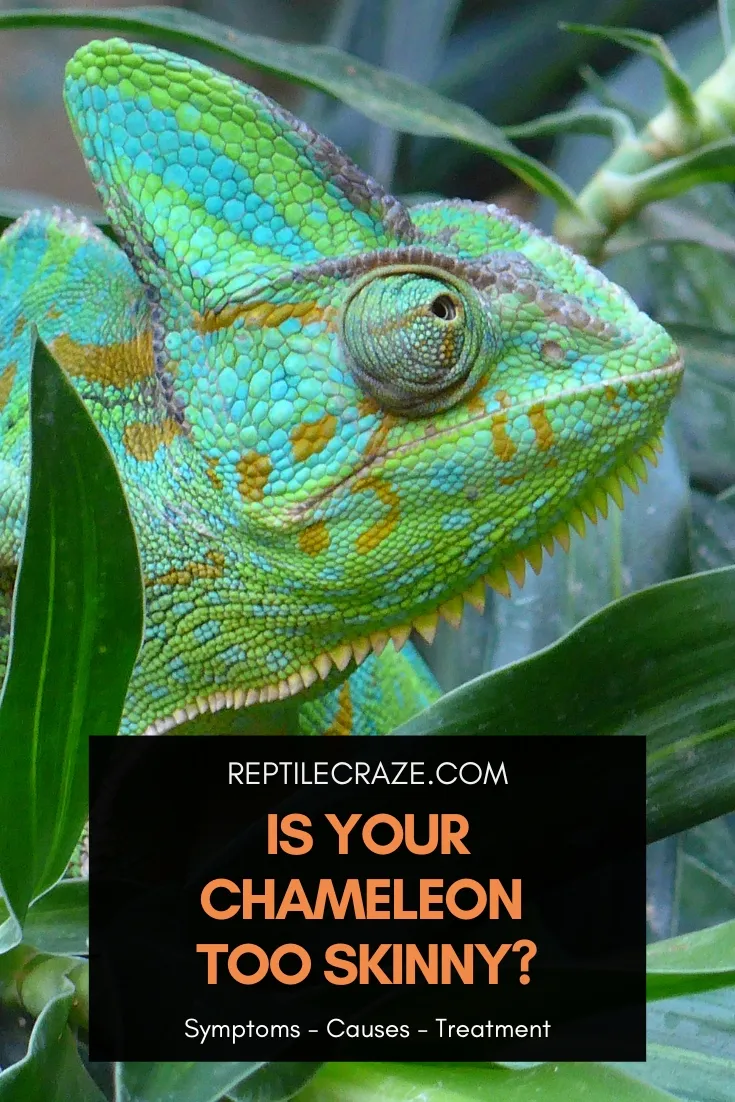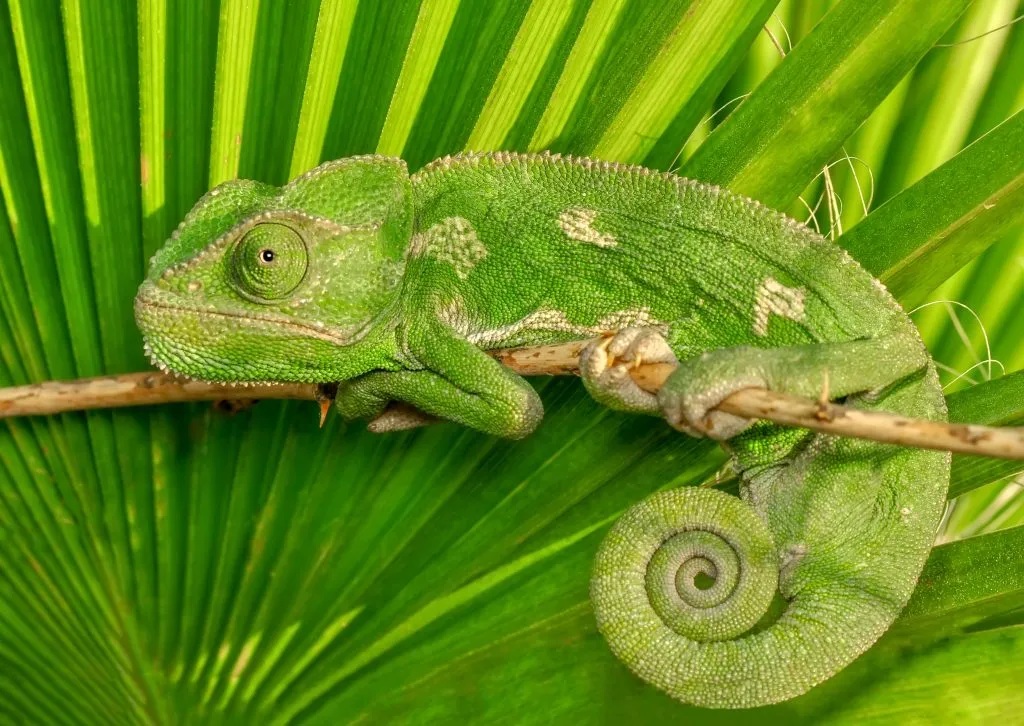
Chameleons aren’t the chubbiest of creatures to begin with. However, there are certainly times when a chameleon becomes too skinny and noticeably unhealthy, and recognizing its signs early enough can help prevent serious issues.
Your chameleon might be underweight if it has a sunken casque, a very prominent pelvic girdle, and boney limbs and tail. Common reasons for this include deficiencies, infections, and stress, most of which can be treated and prevented by a nutrient-rich diet and well-maintained housing.
This post will go into detail about how to distinguish underweight chameleons from healthy ones, the possible reasons behind them becoming skinny, and what you can do to prevent and treat the issue. Read on!
Table of Contents
Signs of Healthy vs Underweight Chameleons
Being the naturally lean creatures that they are, it can be hard to distinguish between healthy chameleons and alarmingly skinny ones.
But with careful examination of its body traits, you can determine if your chameleon has become way too skinny than what’s considered normal. Here are some ways you can assess this:
Shape of the Pelvic Girdle
Chameleons store most of their fat near the hips, so naturally, well-fed ones will have slightly rounded hips.
However, if the pelvic girdle is way too obvious, and the bones from within can be seen protruding, your chameleon is likely underweight.
Shape of the Casque and Cheeks

The second place where chameleons store fat is within their casque – the protruding bone at the top of their heads.
You want your chameleon’s casque to be lean and slightly padded (but not swelled up, because that could pinpoint towards obesity).
However, if the casque is very boney and sunken in appearance, then your chameleon could be too skinny for its own good.
The same goes for their cheeks – if they’re slightly rounded, your chameleon is doing fine, but if they’re sunken in, then it’s a cause for concern.
Shape of the Belly
When relaxed, your chameleon should have a rounded belly. A constantly flat abdomen and belly could mean your lizard doesn’t have enough fat on its body.
Note: chameleons tend to flatten their bodies when they feel threatened or have to expand their surface area to thermoregulate. So it’s best to observe the shape of their bellies when they’re relaxed or sleeping.
Ridge at the Back
The boney ridge that goes along the back of your chameleons can become too pronounced and prominent if it’s underweight.
A chameleon with a healthy weight will still have these ridges, but they won’t protrude as much.
Limbs and Tail
Though lean, healthy chameleons will have muscular limbs and tails. If they seem to have visible bones and a dehydrated sort of appearance, your chameleon is likely too skinny.
Note: a chameleon with its rib cage visible doesn’t necessarily mean it’s skinny. It’s perfectly normal for them to have some visible bones along the abdomen!
Overall Weight
If you own a measuring scale, great! You can measure the weight of your chameleon right away and quickly assess whether it’s healthy or skinny.
Below are the average weights (as adults) for some common species kept as pets.
Do note that these weights can vary widely depending on individuals and their size.
| Species | Weight (Male) | Weight (Female) |
| Veiled Chameleon | 100-200g | 85-130g |
| Jackson’s Chameleon | 90-150g | 80-110g |
| Panther Chameleon | 100-180g | 80-120g |
Why Does My Chameleon Look Skinny? Possible Causes
Some reasons behind your chameleon being skinny are more worrisome than others. Here are the possible causes:
Diet and Deficiencies
Chameleons tend to get bored of eating the same
More importantly, not varying the
Tip: check the bottom of the cage for any insects crawling around. You may think your chameleon has consumed the live insects you dropped in, when in fact, they might be roaming about or hiding under foliage because your pet refused to eat them.
Dehydration
Sunken eyes, wrinkled skin, and loss of appetite – all of which make a chameleon look skinny – may be due to dehydration.
It’s very easy and common for chameleons to become dehydrated, and it can be a fatal condition if not attended to immediately.
Parasites

Although it’s normal for chameleons to carry some parasites, captive ones can often be infected with harmful parasites such as coccidia, which attack the intestinal tract.
This results in appetite loss, weight loss, and an overall decline in health.
Stomatitis
Mouth rot or stomatitis is a common infection among chameleons. These painful swellings in the soft tissues of the mouth can lead to appetite loss.
So if you notice your chameleon refusing
Stress
Chameleons are very sensitive to their surroundings and any changes that may occur in them, and can easily become stressed.
When they’re stressed for a prolonged period, they might stop eating and start to lose weight, contract diseases, and behave unusually.
Feeling Threatened
When they feel threatened, chameleons flatten their bodies or suck in their abdomen to hide, which makes them look very skinny.
If you always notice your chameleon with a flat body, chances are that it’s scared whenever you approach its
Treatment and Help for Skinny Chameleons

Luckily, there are certain measures you can take to ensure your chameleon maintains a healthy weight. Here’s how you can help:
Provide Nutrients
Try to provide your chameleon with a variety of insects and switch them up every other day to keep it interesting for them.
Stuff like crickets, dubia roaches, and silkworms should be staples in their diet, as they have high nutritional value.
Also, ensure that you dust live prey with supplements and gut-load them with fruits, collard greens, and other veggies to provide essential vitamins and minerals to your chameleon.
Doing so will help your chameleon gain weight healthily – we don’t recommend trying to ‘fatten up’ chameleons by feeding them fatty foods.
If your chameleon is always eating its shed skin, that’s a sign that it might be nutrient deficient, as we explain here.
Note: chameleons can get addicted to super worms and wax worms – insects known to have very little nutritional value – and may refuse to eat anything other than them. Remember to only feed these to your chameleon as an occasional treat.
Provide Enough Humidity
Just by maintaining an optimum humidity level between 60-80%, you can save your chameleon from a lot of unnecessary stress, illnesses, and weight loss.
Mist regularly (or better yet, get an automatic mister), have drippers installed in strategic locations, and use real plants to retain water for a longer time. A shower can also help chameleons that are more dehydrated than usual.
However, if your chameleon is very dehydrated with sunken eyes and wrinkled skin, take it to a vet on an urgent basis.
Tip: If you are worried that your chameleon might be dying, read our article on signs your chameleon is dying here!
Appropriate Housing
An important preventive measure for weight loss and illnesses is ensuring good housing with an appropriate environment for your chameleon.
A spacious cage, a proper UVB light and heating setup, hygrometers, and thermometers to measure humidity and temperature is essential for maintaining an optimum environment. A happy chameleon is a healthy chameleon!
Visit the Vet!

If all the above boxes are ticked and your chameleon still seems too skinny, it’s time to visit a certified veterinarian who can prescribe the appropriate treatment plan.
Your beloved pet might be suffering from infections or a serious underlying illness that can only be diagnosed through fecal exams and blood work.
Final Thoughts
Chameleons being skinny isn’t usually a cause for concern, and having a nutritious diet plan usually does the trick.
However, it’s always better to check in with a vet to ensure your chameleon is the correct weight for its age and is healthy.
- Enchi Ball Python: A Unique and Stunning Morph of Python regius - March 27, 2025
- Emerald Tree Monitor: The Enigmatic Green Guardian of the Rainforest - March 26, 2025
- The Egyptian Cobra (Naja haje): A Fascinating Serpent - March 25, 2025
